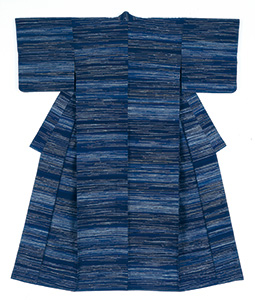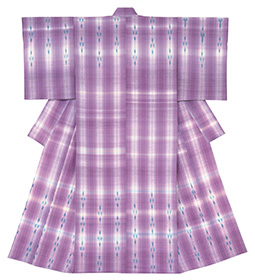
Autumn haze (1958) (made by Shimura Fukumi) [Dye: indigo] 
Dream of Zenmyo*** (2009) (made by Shimura Yoko) [Dyes: shikon, indigo, and kariyasu]
October 2020
Dyeing by Natural Color

Shimura Fukumi is a dyeing and weaving artist who dyes silk thread with natural plant materials to create hand-woven kimonos, tapestries and other works. In addition to being recognized as a holder of Important Intangible Cultural Properties, also known as a Living National Treasure, she has received numerous awards, including the Order of Culture*. We spoke with her daughter, Shimura Yoko, who has inherited her mother’s techniques and ideas.
You create textiles using threads made from plant-based dyes. Can you tell us about their allure?
For our plant-based dye work, thread is taken from silkworm cocoons and immersed in a dye extracted from plants. These threads are then submerged in water mixed with lye made from the ash of burned wood or other materials to set the color. We can experience the mysteries and beauty of nature through plant-based dyes made only from natural materials. All the colors created by this process are excellent. My mother, Fukumi, expresses this by saying that we, “humbly receive color from plants.” It is said that the allure of plant-based dyes is the fact that the life taken from living plants is reclaimed as a beautiful color.
I think that nowadays, there are fewer and fewer countries around the world where textiles dyed with plant-based dyes are still passed on as traditional techniques as in Japan. Upon seeing the brilliantly colored kimono when coming to tour our atelier, the CEO of a famous European clothing brand asked how we printed the designs on our textiles. It seems he didn’t believe it was possible to express detailed kasuri** (ikat) patterns with plant-based dyes.

What color do you particularly treasure?
Indigo. Indigo is one of the colors that represents Japan, and has been loved by Japanese people since ancient times. My grandmother says that there is nothing that makes a Japanese woman more beautiful than an indigo-dyed kimono, and she always wore a kimono with an indigo kasuri pattern. The reason I came to enter the dyeing world is that I was fascinated by the indigo dye that my mother had worked with for many years.
It is possible also to create a green color from indigo. In fact, it is not possible to dye fabric with a beautiful green color from the green leaves of plants. The color green is created by combining indigo with a yellow color. Thread is dyed with a brilliant green color by immersing thread dyed yellow by a type of grass called kariyasu (Miscanthus tinctorius) in an indigo dye vat.
Purple is another one of my favorite colors. Purple has had noble connotations since ancient times, reflected in the name Murasaki Shikibu (Murasaki means “purple”), the author of The Tale of Genji, which was written in the eleventh century. Purple color is made by using a dye extracted from the root (shikon) of the murasaki plant (lithospermum purpurocaeruleum), which blooms with lovely white flowers. I think that people appear more elegant when wearing a kimono dyed from shikon.
Colors dyed from plant-based dyes do not fade, but rather change as time passes. The colors subtly increase in depth and the kimono begins to show a distinct character. It is as if the colors are living.

Tell us about the expressions characteristic of plant-based dyes and how they have been handed down.
We were once requested to make a kimono dyed using a cherry blossom tree cherished by a deceased relative that had to be cut down from the garden. Cherry blossom pink dye is extracted not from the cherry blossom petals, but from the trunk and branches that have been finely cut. The life of the cherry blossom tree was resurrected by being made into a pale rose color kimono, and has been passed down in the family along with its memories. Being able to see this circle of life through color is precisely because of plant-based dyes.
In 2013, we established an arts school in Kyoto. We offer education that fosters the sensibilities necessary to express oneself through textile arts by having students acquire not just the techniques of dyeing and weaving, but also through learning about philosophy, literature, and by getting in touch with nature. At the graduation ceremony, everyone wears a kimono that they wove themselves using thread that they dyed themselves. Since 2016, we have been teaching classes four times a year to fourth year students in a primary school in Kyoto where we dye fabric using seasonal plants, such as cherry blossoms and chestnuts. In addition to dyeing, we have the children give the colors a name of their own. We will continue to pass on the traditions and spirit of plant-based dyes to the next generation through these kinds of activities.
* The Order of Culture is awarded to individuals who have made outstanding contributions to Japanese culture.
** Kasuri are textiles that show patterns through weaving with threads that have been separately dyed beforehand
*** Zenmyo is the name of a woman transformed into a dragon who appears in the thirteenth-century Buddhist (Kegon) story and picture scroll Legends of the Kegon Sect.

